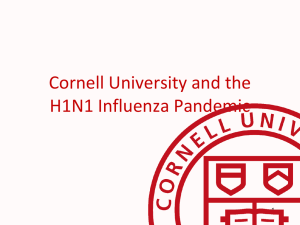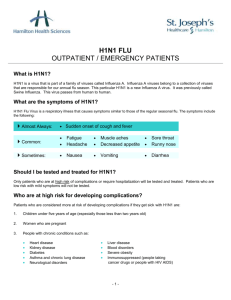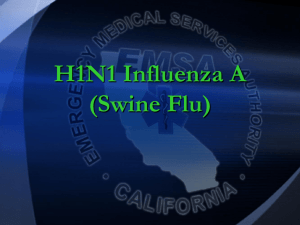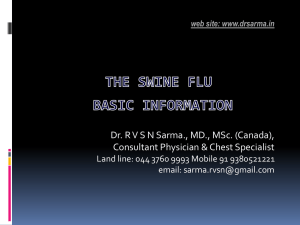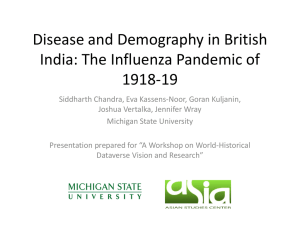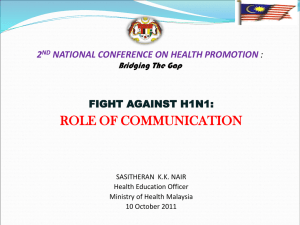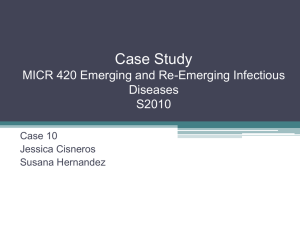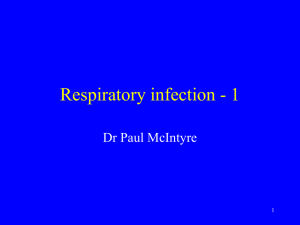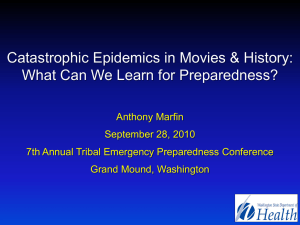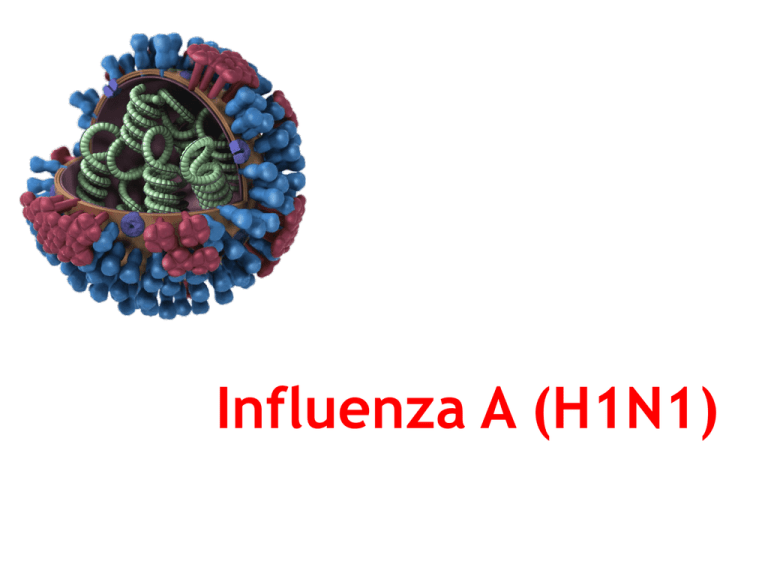
Influenza A (H1N1)
Influenza A (H1N1) (Swine flu)
• Swine flu is a respiratory disease of pigs caused
by Type A Influenza virus that causes regular
outbreaks in pigs
• Swine flu viruses have been reported to spread
from person-to-person, however transmission
was limited
• The current pandemic started in Mexico in 2009
and now declared as seasonal influenza
Pandemics of influenza
Recorded human pandemic influenza
(early sub-types inferred)
H2N2
H2N2
H1N1
H1N1
H3N8
1895 1905
1889
Russian
influenza
H2N2
1915
Pandemic
H3N2
1925
1900
Old Hong Kong
influenza
H3N8
1955
1918
Spanish
influenza
H1N1
1965
1957
Asian
influenza
H2N2
1975
H1N1
1985
H9*
H5
H7
3
Reproduced and adapted (2009) with permission of Dr Masato Tashiro, Director, Center for Influenza Virus Research,
National Institute of Infectious Diseases (NIID), Japan.
1965
1975
1980
1985
2005
2010
2009
Pandemic
influenza
H1N1
1968
Hong Kong
influenza
H3N2
Recorded new avian influenzas
1955
1995
1999
1997 2003
1996
1995
2002
2005
Animated slide: Press space bar
2015
Phases of Pandemic Influenza
Influenza A (H1N1) (Swine flu)
• Swine flu is a respiratory disease of pigs
caused by Type A Influenza virus that
causes regular outbreaks in pigs
• Swine flu viruses have been reported to
spread from person-to-person,
however transmission was limited
• During pandemic and post pandemic
situation widespread human to human
infection occurs
What is Influenza A (H1N1) ?
• Viral infection.
• Genetic mixing of three different
viruses
• Highly susceptible to oseltamivir
Current Situation
• Global
– First case reported on 18th March 2009
– WHO declared Post Pandemic – June 2010
• India
• Pandemic Phase – May 2009 to Dec 2010
• Post Pandemic Phase – Jan 2011 – Dec 2014
• Circulate as Seasonal Influenza
• Tamil Nadu
• First case : 1st May 2009 & Declined in 2011
• Cases continue to report sporadically
Tamil Nadu
Year
Samples
Positives
Positivity
Rate
Deaths
CFR
2009
23625
3047
12.9
10
0.33
2010
9630
1405
14.6
24
1.71
2011
786
34
4.3
4
11.76
2012
5058
750
14.8
40
5.33
2013
2528
37
1.5
6
16.22
2014
1363
58
4.3
8
13.79
2015*
196
36
18.4
4
11.11
*Up to 20.01.2015
Place Distribution
2014
2015
S.no
HUD
Cases Deaths Cases Deaths
1 Chennai
18
1
7
1
2 Coimbatore
8
2
8
1
3 Vellore
6
5
4 Erode
3
1
3
1
5 Kancheepuram
3
6 Thiruppathur
3
7 Thiruvallur
3
2
1
8 Salem
2
2
9 Thiruvannamalai
2
10 Villupuram
2
1
-
Place Distribution
S.no
11
12
13
14
15
16
17
18
19
20
HUD
Cuddalore
Kanniyakumari
Krishnagiri
Namakkal
Ramnad
Saidapet
The Nilgiris
Thiruppur
Dharmapuri
Madurai
Total
2014
2015
Cases Deaths Cases Deaths
1
1
1
1
1
1
1
1
0
1
3
1
1
1
0
2
1
1
1
58
8
36
4
A H1N1 Positive Cases - Age wise distribution
in
Tamil Nadu- 2014 ( n = 58 )
30.0%
24.1%
25.0%
20.0%
17.2%
17.2%
15.0%
12.1%
12.1%
10.3%
10.0%
5.2%
5.0%
1.7%
0.0%
0.0%
11-15
16-20
0.0%
0.0%
0-5
6-10
21-30
31-40
Age in Years
41-50
51-60
61-70
71-80
> 80
SEX WISE DISTRIBUTION OF 'A H1N1' CASES
IN TAMIL NADU-2014
(n= 58)
34
35
30
41.4%
58.6%
24
25
20
15
10
5
0
Male
Female
A H1N1 Positive Cases - Age wise distribution
in Tamil Nadu- 2015*
( n = 36 )
25.0%
19.4%
20.0%
16.7%
16.7%
15.0%
11.1%
10.0%
11.1%
8.3%
5.6%
5.6%
5.6%
5.0%
0.0%
0.0%
0.0%
0-5
6-10
11-15
16-20
21-30
31-40
Age in Years
(Up to 20-01-2015)
41-50
51-60
61-70
71-80
> 80
SEX WISE DISTRIBUTION OF 'A H1N1' CASES IN
TAMIL NADU-2015*
(n= 36) )
20
20
18
16
44.4%
55.6%
16
14
12
10
8
6
4
2
0
Male
(Up to 20-01-2015)
Female
Laboratories Identified for
Testing
Sl. No
1
2
3
4
5
6
7
1
2
3
4
5
6
7
8
9
10
11
12
13
Name of the Laboratory
Government
King Institute of Preventive Medicine, Guindy Chennai
Madras Medical College and Research Institute, Chennai
Coimbatore Medical College, Coimbatore
Tirunelveli Medical College, Tirunelveli
KAP Vishwanathan Medical College, Tiruchirapalli
Madurai Medical College, Madurai
JIPMER, Pondycherry
Private
Bharat Specialities Lab, Chennai
Hitech Diagnostics Centre, Chennai
Lister Metropolis Laboratory and Research Centre(P) Ltd
Sri Ramachandra Medical College, Porur Chennai
Diagnostic services, T Nagar, Chennai
Immuno Ancillary Clinical Services, Coimbatore
Microbiology Laboratory, Coimbatore
Vivek Laboratory, Nagercoil
Doctor’s Doagnostic centre, Tiruchirapalli
Premier Health centre, Chennai
Star biotech solution, Chennai
Christian Medical College, Vellore
Narayana Hiruthayala Hospital, Kartanaka
Epidemiology of AH1N1
Case Definition*
A suspected case
Acute febrile respiratory illness who
• Develops symptoms within seven days of close
contact with a person who is a confirmed case of
H1N1 influenza A virus infection or
• Develops symptoms within seven days of travel or
resides in a community where there are one or
more confirmed A H1N1 influenza cases
* CDC definition
Case Definition
• A probable case:
Acute febrile respiratory illness who is
positive for influenza A, but negative for H1
and H3 by RT-PCR
• A confirmed case
Acute febrile respiratory illness with
laboratory-confirmed H1N1 influenza A virus
detection by real-time reverse transcriptase
PCR (RT-PCR) or culture.
Mode of transmission
• People become infected by touching
something with live flu viruses on it and then
touching their mouth or nose
(More than 80%)
• Viruses are spread from person to person by
droplet through coughing or sneezing of
people with influenza.
Communicability
• From one day before to 7 days after the onset
of symptoms.
• If illness persists for more than 7 days,
communicability may persist.
• Children, especially younger children, might
potentially be contagious for longer periods.
Clinical features
Vomiting or diarrhea (not typical for influenza but reported by
recent cases of swine influenza infection)
Other Manifestations
•
•
•
•
•
•
•
Tachycardia
Tachypnoea
Low O2 sat.
Hypotension
Cyanosis
Acute myocarditis
Cardiopulmonary arrest
High Risk Group
•
•
•
•
Asthma
Pregnancy
Age above 65 Years
Children under five
years
• Chronic lung disease
• Chronic heart disease
• Chronic kidney disease
• Chronic liver disease
• Chronic neurological
disease
• Immunosuppressant
(whether caused by
disease or treatment)
• Diabetes mellitus
• Obesity
Investigations
• Routine investigations for evaluation and
management of symptoms
– Hematological, bio chemical, radiological and
micro biological tests
• Confirmation of influenza
– Real Time RT – PCR
– Isolation of virus in culture
– Four fold rise in virus specific neutralizing
antibodies
Case Management
• Prompt treatment to prevent severe
illness and death
Supportive treatment (Antipyretics,
antibiotics, IV fluids, Oxygen therapy,
nutrition, saline gorgling, mucolytics
etc)
Specific anti viral treatment
(Oseltamivir)
Antiviral treatment
• Oseltamivir (Tami flu) is the drug of choice
for treatment and chemoprophylaxis.
• Available in capsule (75 mg, 45 mg and 30
mg) and syrup form (60 ml bottle= 12 mg per
ml)
• For treatment, antiviral drugs work best if
started soon after getting sick
• Reduces the duration of virus excretion and
the severity of illness
Antiviral treatment for cases
• Duration of treatment: 5 days BD
• Dosage schedule
Weight
Dosage
<15 kg
30 mg BD 5Days
15-23 kg
45 mg BD 5Days
24 to <40kg
60 mg BD 5Days
>40 kg
75 mg BD 5Days
Antiviral treatment for casesInfants
• Duration of treatment: 5 days BD
• Available as oral suspension
• Dosage schedule
Months
Dosage
<3 months
12mg BD 5Days
3-5 months
20mg BD 5Days
6-11 months
25mg BD 5Days
Contact tracing and
chemoprophylaxis
• Powerful public health intervention to
interrupt the transmission
• All contacts of confirmed cases are to
be administered with Oseltamivir
(Tami flu) irrespective of whether
they have symptoms or not
Antiviral dosage for
chemoprophylaxis
• Duration of treatment: 10 days OD
• Dosage schedule
Weight
<15 kg
15-23kg
24to<40kg
>40 kg
Dosage
30 mg OD 10 Days
45mg OD 10 Days
60mg OD 10 Days
75mg OD 10 Days
Antiviral dosage for
chemoprophylaxis -infants
• Duration of treatment: 10 days OD
• Chemoprophylaxis not recommended for children
below 3 months generally
• Dosage schedule
Months
Dosage
3-5 months
20 mg OD 10 Days
6-11 months
25 mg OD 10 Days
Guidelines for hand washing in
Health Care Settings
• Use surgical spirit (70% alcohol or more)
• Wash hands before and after seeing
every patient
• Discard basins with antiseptic lotions
for handwashing
HAND HYGIENE
HAND HYGIENE
Disinfectants
• 1 to 10% Sodium or Calcium
hypochlorite solution – for disinfecting
instruments and infected body fluids
• 5% lysol – Decontamination of floor by
mopping
• Surgical spirit with minimum of 70%
alcohol – For disinfecting Hands
Guidelines for schools
• Daily screening
• Students/ teacher with flu like condition
should be sent to a doctor
• Home isolation/ admission in isolation ward
as per category
• Disinfect the class rooms before the
commencement of next class
(Floor with 5% lysol and other surfaces including desk with
surgical spirit)
Guidelines for cinema theatres
• Disinfect the theatre before the
commencement of next show
- Floor with 5% lysol or 1% hypochlorite
solution
- Seats, ticket counters and other surfaces
with surgical spirit
Guidelines for marriage halls and
other community halls
• Disinfect the hall before the
commencement of next function
- Floor with 5% lysol or 1%
hypochlorite solution
- Seats and other surfaces with surgical
spirit
Guidelines for lodging houses
• Disinfect the room before allotting to
the next guest
- Floor with 5% lysol or hypochlorite solution
- Seats, teapoy, TV remote, door handles and
other surfaces with surgical spirit
Guidelines for Public Transport
• Disinfect the vehicle particularly the
areas touched by hands at the end of
every trip
- Floor with 5% lysol
- Seats and other surfaces with surgical
spirit
Guidelines for Public Places
• Improve general cleanliness
-Floor with 5% lysol or hypochlorite solution
-Seats and other surfaces with surgical spirit
• Liberal use of disinfectants
What should I do?
• First and most important: wash your
•
•
•
hands
Practice cough etiquette
Avoid touching surfaces that may be
contaminated with the flu virus.
Avoid close contact with people having
flu like illness
What should I do?
• Staying at home if you have flu like
symptoms
• Educating school children and staff, advising
avoidance of mass gatherings
• Avoid crowded places, avoid hand shaking
• Avoid picnics


